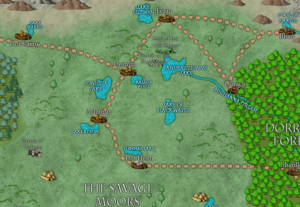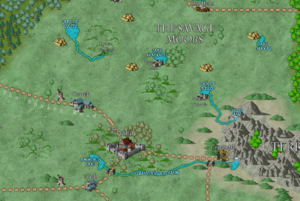Difference between revisions of "Savage Moors"
EverDAdmin (Talk | contribs) |
EverDAdmin (Talk | contribs) (→Shrine of the Red Moon) |
||
| (9 intermediate revisions by the same user not shown) | |||
| Line 1: | Line 1: | ||
| − | The Savage Moors are a large expanse between Vallyrin Wood and Dorresse Forest, in the northeastern Midlands. They reach from the foothills of the [[World's Crown Mountains]] south to the [[Terralosa Mountains]] and the [[Granitefall Stream]]. | + | The [[Savage Moors]] are a large expanse between [[Vallyrin Wood]] and [[Dorresse Forest]], in the northeastern Midlands. They reach from the foothills of the [[World's Crown Mountains]] south to the [[Terralosa Mountains]] and the [[Granitefall Stream]]. |
The land here is fertile enough to support agriculture, but the ground is rocky and broken, dotted with lakes (large and small) and swamps. This lends itself to many small, scattered, self-sustaining communities and matches well with tribal cultures like the [[Allanyn]], [[Tharr]], traditional [[Torrethi]], and [[Oriloth]]. The primary populations here are primarily the Allayn and Oriloth, with scatterings of Tharr clans among the Allanyn in the north and some Torrethi settlements in the south near [[Thalia]] and the slopes of the [[Terralosa Mountains]]. | The land here is fertile enough to support agriculture, but the ground is rocky and broken, dotted with lakes (large and small) and swamps. This lends itself to many small, scattered, self-sustaining communities and matches well with tribal cultures like the [[Allanyn]], [[Tharr]], traditional [[Torrethi]], and [[Oriloth]]. The primary populations here are primarily the Allayn and Oriloth, with scatterings of Tharr clans among the Allanyn in the north and some Torrethi settlements in the south near [[Thalia]] and the slopes of the [[Terralosa Mountains]]. | ||
| Line 9: | Line 9: | ||
=== Walled Settlements === | === Walled Settlements === | ||
| − | [[file:Savage Moors.PNG|300px|right|text-top]] | + | [[file:Savage Moors.PNG|300px|right|text-top|The northern Savage Moors.]] |
The northern third or so of the Savage Moors that contains most of the Allanyn and Tharr populations does have a number of established, walled settlements. Of special mention are [[Dor Karro]] and [[Dor Henn]], which are more like fortresses than true cities. These two settlements are nearest to barbaric Tharr and Oriloth raiders, respectively. Dor Karro is astride the road to [[Orrasteyr]] in the Vallyrin, which sits at the source of the Red Feather branch of the [[Raven River]] and the Allanyn of the Savage Moors' only connection to the rest of the Midlands. Dor Henn, as the southernmost Allanyn settlement, is the chief and foremost defense against southern raiders. | The northern third or so of the Savage Moors that contains most of the Allanyn and Tharr populations does have a number of established, walled settlements. Of special mention are [[Dor Karro]] and [[Dor Henn]], which are more like fortresses than true cities. These two settlements are nearest to barbaric Tharr and Oriloth raiders, respectively. Dor Karro is astride the road to [[Orrasteyr]] in the Vallyrin, which sits at the source of the Red Feather branch of the [[Raven River]] and the Allanyn of the Savage Moors' only connection to the rest of the Midlands. Dor Henn, as the southernmost Allanyn settlement, is the chief and foremost defense against southern raiders. | ||
| Line 21: | Line 21: | ||
This is the largest temple of [[Allana]] in Terryth, consisting of many large pillars and standing stones, ritual buildings, a great sacrificial altar, and a sacred pool. The high priestess of this Shrine, known as the ''kel domarra'', commands significant respect and influence among the Allanyn generally and in the Savage Moors specifically. | This is the largest temple of [[Allana]] in Terryth, consisting of many large pillars and standing stones, ritual buildings, a great sacrificial altar, and a sacred pool. The high priestess of this Shrine, known as the ''kel domarra'', commands significant respect and influence among the Allanyn generally and in the Savage Moors specifically. | ||
| + | |||
| + | The name of the shrine relates to the astronomical event of the "Blood Moon," when [[Myarra]]'s color changes from grey to red. As Myarra is associated with Alanna, and women and their cycles in general, the symbolism here is obvious. Sacrifices are always held here on nights of the Blood Moon. | ||
=== Lake of Black Water === | === Lake of Black Water === | ||
| Line 26: | Line 28: | ||
The water of this lake is not literally black, nor even especially discolored, but is known to be poisonous. No living creature may drink from it, for even the smallest sip causes cramps and pain. Any more leads to death. Even the beasts avoid it. Accordingly, this is one of the only large lakes in the Savage Moors without a permanent settlement. It also tends to deter raiders, for fear that whatever taints the water here seeps into other nearby sources. | The water of this lake is not literally black, nor even especially discolored, but is known to be poisonous. No living creature may drink from it, for even the smallest sip causes cramps and pain. Any more leads to death. Even the beasts avoid it. Accordingly, this is one of the only large lakes in the Savage Moors without a permanent settlement. It also tends to deter raiders, for fear that whatever taints the water here seeps into other nearby sources. | ||
| − | === Ruins === | + | === Ruins and the South === |
| + | [[file:Savage_Moors_(South).PNG|300px|right|text-top|The southern Savage Moors.]] | ||
There are several ruined towns in the southern part of the Savage Moors, both of old Allanyn and Torrethi style; conquered and razed by the invading Oriloth, long ago. They serve as constant reminders of Orilothi invasion and brutality and fuels the desire for revenge and reconquest with every generation who learns how their forefathers and mothers were slaughtered and displaced. | There are several ruined towns in the southern part of the Savage Moors, both of old Allanyn and Torrethi style; conquered and razed by the invading Oriloth, long ago. They serve as constant reminders of Orilothi invasion and brutality and fuels the desire for revenge and reconquest with every generation who learns how their forefathers and mothers were slaughtered and displaced. | ||
| + | |||
| + | Now, of course, the southern region north of [[Thalia]] and [[Corrith]] is teeming with Oriloth tribes. These tribes form, dissolve, grow, shrink, and move with the fortunes of their chieftains, and their raids are troublesome to travelers along the [[Sunken Road]], Torrethi in the mountains, and even the ''[[Sarendar]]'' of Thalia. On rare occasions, perhaps once or twice per generation, a great Orilothi leader manages to create a confederation of tribes stronger than normal and launch a serious invasion. Usually, these invasions go north toward their ancestral enemies in the northern Savage Moors, but sometimes they try their luck south against the Torrethi. | ||
Latest revision as of 17:20, 13 March 2021
The Savage Moors are a large expanse between Vallyrin Wood and Dorresse Forest, in the northeastern Midlands. They reach from the foothills of the World's Crown Mountains south to the Terralosa Mountains and the Granitefall Stream.
The land here is fertile enough to support agriculture, but the ground is rocky and broken, dotted with lakes (large and small) and swamps. This lends itself to many small, scattered, self-sustaining communities and matches well with tribal cultures like the Allanyn, Tharr, traditional Torrethi, and Oriloth. The primary populations here are primarily the Allayn and Oriloth, with scatterings of Tharr clans among the Allanyn in the north and some Torrethi settlements in the south near Thalia and the slopes of the Terralosa Mountains.
Contents
Conflict[edit]
The Savage Moors were so-named by Imperial geographers not because of their physical characteristics or remoteness, but because of the constant conflict to be found there. Tribal cultures are prone to feuds and combativeness anyway, but when you add in the deliberate predations of Oriloth and Tharr raiders with customs of revenge, the result is near-perpetual warfare that sometimes borders on the genocidal. In the worst of these conflicts, entire settlements are massacred or enslaved, emptying the land for the victors' own people to enter and settle it.
Walled Settlements[edit]
The northern third or so of the Savage Moors that contains most of the Allanyn and Tharr populations does have a number of established, walled settlements. Of special mention are Dor Karro and Dor Henn, which are more like fortresses than true cities. These two settlements are nearest to barbaric Tharr and Oriloth raiders, respectively. Dor Karro is astride the road to Orrasteyr in the Vallyrin, which sits at the source of the Red Feather branch of the Raven River and the Allanyn of the Savage Moors' only connection to the rest of the Midlands. Dor Henn, as the southernmost Allanyn settlement, is the chief and foremost defense against southern raiders.
Achinnar, Gorach, Desmin, Echin, and Illsan are walled towns. Their fixed populations range from 4,000 to about 8,000, but they contain surge space for surrounding peoples to flee, and can fit from 10,000 to 15,000 in times of trouble. Numerous other, smaller settlements dot the landscape.
Hall of the Old Kings[edit]
This is an ancient burial place of many tombs. The identity of who lies here is uncertain and varies by the tale, but the tombs are largely intact. Warnings of traps and evil spirits keep away most, and those who are not deterred tend to vanish soon after going there. Most Allanyn are content to let their ancient dead well enough alone.
Shrine of the Red Moon[edit]
This is the largest temple of Allana in Terryth, consisting of many large pillars and standing stones, ritual buildings, a great sacrificial altar, and a sacred pool. The high priestess of this Shrine, known as the kel domarra, commands significant respect and influence among the Allanyn generally and in the Savage Moors specifically.
The name of the shrine relates to the astronomical event of the "Blood Moon," when Myarra's color changes from grey to red. As Myarra is associated with Alanna, and women and their cycles in general, the symbolism here is obvious. Sacrifices are always held here on nights of the Blood Moon.
Lake of Black Water[edit]
The water of this lake is not literally black, nor even especially discolored, but is known to be poisonous. No living creature may drink from it, for even the smallest sip causes cramps and pain. Any more leads to death. Even the beasts avoid it. Accordingly, this is one of the only large lakes in the Savage Moors without a permanent settlement. It also tends to deter raiders, for fear that whatever taints the water here seeps into other nearby sources.
Ruins and the South[edit]
There are several ruined towns in the southern part of the Savage Moors, both of old Allanyn and Torrethi style; conquered and razed by the invading Oriloth, long ago. They serve as constant reminders of Orilothi invasion and brutality and fuels the desire for revenge and reconquest with every generation who learns how their forefathers and mothers were slaughtered and displaced.
Now, of course, the southern region north of Thalia and Corrith is teeming with Oriloth tribes. These tribes form, dissolve, grow, shrink, and move with the fortunes of their chieftains, and their raids are troublesome to travelers along the Sunken Road, Torrethi in the mountains, and even the Sarendar of Thalia. On rare occasions, perhaps once or twice per generation, a great Orilothi leader manages to create a confederation of tribes stronger than normal and launch a serious invasion. Usually, these invasions go north toward their ancestral enemies in the northern Savage Moors, but sometimes they try their luck south against the Torrethi.

